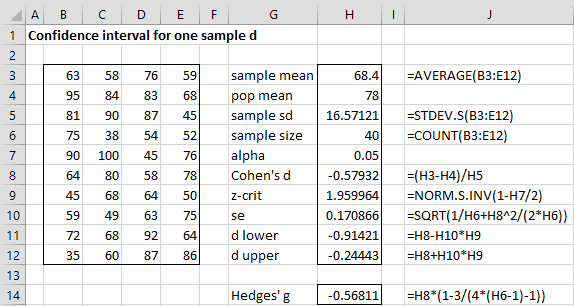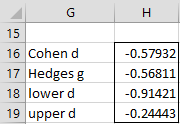Cohen’s d Effect Size
As explained in Standardized Effect Size, when the population variance is known we can use Cohen’s d as an estimate of effect size where:
When the population variance is unknown, we can use the sample standard deviation as an estimate of the population standard deviation
![]()
Interpretation
The default interpretation of Cohen’s d effect size is
- .20: small effect
- .50: medium effect
- .80: large effect
Hedges’s g Effect Size
It turns out that Cohen’s d effect size statistic is biased, especially for small samples (n < 20). Hedges’s effect size g serves as an unbiased estimator of the population effect size.
where df = n – 1 and m = df/2. Here Γ(m) is the gamma function.
Example 1: Calculate the d and g effect sizes for Example 2 of One-Sample t-Test.
![]()
![]()
![]()
which indicates a medium effect. Except for the sign, the value of Cohen’s d is the same as that obtained using the T Test and Non-parametric Equivalents data analysis tool (see cell V51 in Figure 7 of One-Sample t-Test).
Confidence Interval
We show how to calculate a confidence interval for Cohen’s d from a one-sample t-test, using an approach from Hedges and Olkin (1985). The 1–α confidence interval is
d ± se · zcrit
where zcrit = NORM.S.INV(1-α/2) and

For Example 2 of One-Sample t-Test, the calculation of the 95% confidence interval for d is shown in Figure 1.
Figure 1 – 95% confidence interval for Cohen’s d
Worksheet Functions
Real Statistics Functions: The Real Statistics Resource Pack provides the following array functions.
T_EFFECT1(m, s, n, lab, alpha, 0) = column array with the values Cohen’s d, Hedges’ g, and the lower and upper confidence interval limits for d based on a one-sample t-test for data with mean m, standard deviation s and sample size n.
TT_EFFECT1(R1, hyp, lab, alpha, 0) = T_EFFECT(m, s, n, lab, alpha, 0) where m = AVERAGE(R1), s = STEV.S(R1) and n = COUNT(R1).
alpha is the significance level (default .05). If lab = TRUE (default FALSE) then an extra column of labels is appended to the output. hyp = the hypothetical (i.e. population) mean (default 0).
Note that the last argument in these functions is 0, in which case the Hedges and Olkin confidence interval is returned. If this last argument is a positive integer (default), then the confidence interval is based on the noncentrality parameter, as defined in Confidence Intervals for Effect Size and Power.
For Example 2 of One-Sample t-Test, the array formulas =T_EFFECT1(68.4-78, 16.57, 40, TRUE, .05, 0) and =TT_EFFECT1(A5:D14, 78, TRUE, .05, 0) result in the output shown in Figure 2.
Figure 2 – Effect size and confidence interval
r-Effect Size
In Dichotomous Variables and the t-test, we describe another measure of effect size, namely the r effect size (aka η or φ), and describe the relationship between r and Cohen’s d. Often r2 (aka η2) is used as the effect size measurement instead of r.
In brief, r2 represents the percentage of the total variance explained by the treatment. It is calculated by

r = .1 represents a small effect, r = .3 represents a medium effect, and r = .5 represents a large effect. The equivalent values for r2 are .01, .09, and .25.
Note that the r effect size for Example 2 of One-Sample t-Test is shown in cell W51 of Figure 7 on that webpage.
Examples Workbook
Click here to download the Excel workbook with the examples described on this webpage.
References
Hedges, L. V. and Olkin, I. (1985) Statistical methods for meta-analysis. Academic Press
https://www.researchgate.net/publication/216811655_Statistical_Methods_in_Meta-Analysis
Enzmann, D. (2015) Notes on Effect Size Measures for the Difference of Means From Two Independent Groups: The Case of Cohen’s d and Hedges’ g
Available through Researchgate
SAGE Publications (2019) t-tests: one-sample, two-independent-sample, and related-samples design.
https://us.sagepub.com/sites/default/files/upm-assets/98047_book_item_98047.pdf
Lakens, D. (2013) Calculating and reporting effect sizes to facilitate cumulative science: a practical primer for t-tests and ANOVAs. Frontiers in Psychology.
https://www.frontiersin.org/articles/10.3389/fpsyg.2013.00863/full
Ellis, P. D. (2010) The essential guide to effect size. Cambridge University Press.
https://books.google.it/books/about/The_Essential_Guide_to_Effect_Sizes.html?id=5obZnfK5pbsC&redir_esc=y
Howell, D. C. (2010) Confidence intervals on effect size
https://www.uvm.edu/~statdhtx/methods8/Supplements/MISC/Confidence%20Intervals%20on%20Effect%20Size.pdf


Excelentes explicaciones profesor…
Thank you for this exposition. Would it be possible to provide an exact citation for the correction factor used in hedges g for the one sample case? Your expression shows an m-.5 term in the denominator. The Hedges paper I have seen shows that it is m-1. But this may be a one-sample vs two sample distinction. Thus the request for the exact citation.
Thank you very much for clearing this up.
Bruce
Figured out the answer to my own question…….
Re-examined Hedges 1981 paper more carefully. Notation mixup.
Bruce
Good to hear.
Charles
Thanks for the clear explanation. One question though. In Cohen’s book ‘Statistical power analysis for the behavioral sciences’ (2nd edition), on page 46 he writes the formula for his d for the one-sample case. He labels this d_3^’ (as it is the third case he describes). On the same page he mentions to use the power tables with n and…d = d_3^’ * SQRT(2).
So, as for the rule of thumb for the interpretation, shouldn’t we first multiply the result of Cohen’s d of the one-sample with the square root of 2 and then see where it fits between 0.2, 0.5 and 0.8?
Hi Peter,
I believe that page 46 of Cohen’s book described how to modify d so that it can be used for power analysis based on a table in his book.
I don’t think this relates to how to interpret the size of d. Keep in mind that the .2, .5, .8 approach is quite inexact to begin with.
Charles
Dear Charles,
Thanks for getting back. I would have guessed that if he defines d = d3*SQRT(2) it would apply to the rules of thumb as well, since those were for d, not d3. But guess it doesn’t matter much.
Peter.